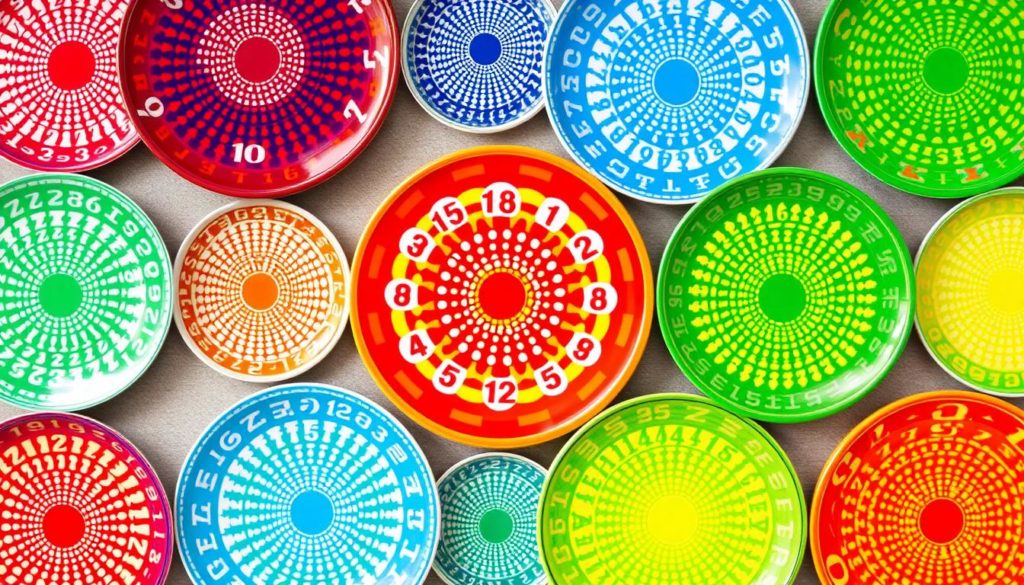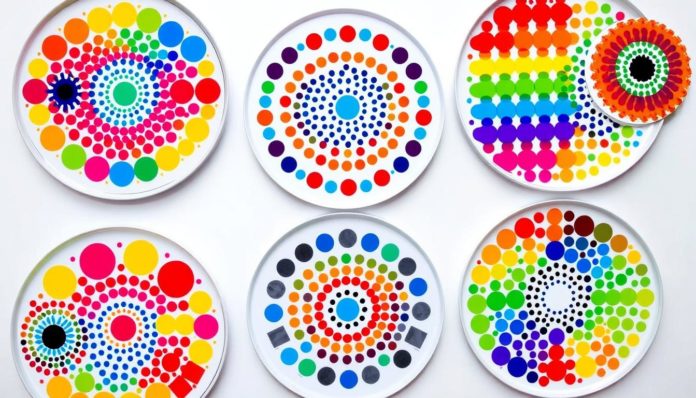Did you know that about 1 in 12 men and 1 in 200 women worldwide have color blindness? This fact shows how common color vision problems are. It’s crucial to know your color vision abilities. In this guide, we’ll look at different color blindness tests and how they work.
These tests are key for both personal and professional reasons. They help you face daily challenges and seize opportunities. Whether you’re checking your clothes or reading signs, these tests are essential.
Color blindness can change your daily life, from picking clothes to reading traffic lights. By understanding your color vision through tests, you can find ways to cope better. Let’s start this journey to discover your color vision type and enhance your life.
What is Color Blindness?
Color blindness, also known as Color Vision Deficiency, makes it hard to see colors right. It can make it tough to tell different colors apart, especially in dim light. Knowing what color blindness is, its types, causes, and symptoms is key.

Definition of Color Blindness
Color blindness means you can’t see colors as well as others. It’s hard to tell reds, greens, or blues apart. This problem usually comes from genes and affects the cone cells in your retina.
Types of Color Blindness
There are different kinds of color blindness, each with its own problems:
- Deuteranopia: Trouble seeing greens.
- Protanopia: Trouble seeing reds.
- Tritanopia: Trouble seeing blues and yellows.
Knowing the type of color blindness you have helps find the right help and support.
Causes and Symptoms
The main Causes of Color Blindness are genes. But aging, sickness, and chemicals can also play a part.
The Symptoms of Color Blindness include trouble telling colors apart and problems in dim light. It can also make it hard to deal with color-coded stuff, affecting daily life and work.
| Type | Color Affected | Symptoms |
|---|---|---|
| Deuteranopia | Green | Difficulty distinguishing greens |
| Protanopia | Red | Difficulty distinguishing reds |
| Tritanopia | Blue and Yellow | Difficulty distinguishing blues and yellows |
Understanding these points is crucial for dealing with Color Vision Deficiency.
Common Color Vision Tests
Understanding color blindness is key. We look at some common Color Vision Tests here.
Ishihara Test
The Ishihara Test is well-known. It uses Ishihara Plates with numbers or patterns in different colors. People try to spot these figures.

EnChroma Glasses Test
The EnChroma Glasses Test is different. Wearing EnChroma glasses can help see colors better. It works best for those with red-green color blindness.
It filters light to make colors clearer.
Tritanomaly Test
The Tritanomaly Screening tests for blue-yellow color blindness. It asks people to find patterns in blue and yellow shades. It’s important for spotting tritanomaly, a rare color blindness type.
| Test | Purpose | Detection |
|---|---|---|
| Ishihara Test | Checking for red-green color blindness | through Ishihara Plates |
| EnChroma Glasses Test | Enhancing color perception | Using EnChroma glasses |
| Tritanomaly Test | Detecting blue-yellow color blindness | Through visual patterns |
Color Blindness Tests: What to Expect
When you’re getting ready for color vision testing, knowing what to expect is key. You’ll find a quiet, well-lit room. It’s designed to help you focus and get accurate results.
“The key to an effective color blindness assessment is a well-arranged testing environment and clear instructions from the examiner.”
During the test, you’ll use standardized charts and tools. You might need to spot numbers or patterns in colored dots, like the Ishihara plates. Always listen to the instructions carefully for the best results.
Before your test, get a good night’s sleep and avoid eye strain from screens. These steps will help you prepare well. Remember, the right environment is key for a good color blindness assessment. Make sure the room is set up for the best testing conditions.
Deuteranomaly Test Explained
Deuteranomaly is a form of red-green color blindness. It affects how the green cones in our eyes see light. This makes it hard to tell red from green, which can affect our daily lives and how we see colors.
How it Works
The Green Color Blindness Test shows colored dots in various patterns. These patterns include numbers or shapes for people to identify. For those with deuteranomaly, it’s hard to tell some colors apart because of their similarity.
Who Should Take It?
If you find it hard to tell red and green apart, or if color blindness runs in your family, you might need a Deuteranomaly Diagnosis. Getting tested early can help you understand and communicate better. This is especially important in jobs where seeing colors is key.
Interpretation of Results
After taking the test, a detailed Test Result Analysis will show your color vision issues. If you have deuteranomaly, the results will tell you how severe it is. They will also suggest ways to manage it.
| Aspect | Normal Vision | Deuteranomaly |
|---|---|---|
| Green Sensitivity | High | Reduced |
| Color Differentiation | Normal | Challenging |
Protanomaly Test: A Detailed Overview
Protanomaly is a color blindness where reds seem duller. They are often mixed up with greens and browns. It’s important to understand and test for this condition to manage it well.
Understanding Protanomaly
Protanomaly happens when genes for red light in the eyes mutate. This leads to less sensitivity to red light. People with protanomaly find it hard to tell reds, greens, browns, and sometimes blues apart.
Testing Process
The Red Color Blindness Test is used to spot protanomaly. It shows images with colored dots and asks people to find numbers or shapes. The Anomaloscope is another tool for a detailed test through color matching.
What Your Results Mean
Knowing your test results helps figure out how bad protanomaly is. You might need special glasses to see colors better. This test affects your daily life and career choices, like in graphic design or electrical work.
So, it’s key to understand your Red Color Blindness Test results. It helps with daily tasks and career decisions.
Advanced Ophthalmology Color Blindness Tests
An ophthalmology color blindness test by an eye specialist is key for a detailed diagnosis. These tests check your color vision and help manage your eye health.
Comprehensive Eye Exams
Comprehensive eye exams are essential for spotting color vision issues. They include specialized color vision assessments that go beyond simple tests. An eye specialist uses various tools to see how your eyes see colors, leading to a more accurate diagnosis.
Specialized Equipment
Eye specialists use specialized equipment like anomaloscopes and spectral tests. These tools give deep insights into color perception. This shows how crucial professional tests are for keeping your eye health top-notch.
Color Blindness Screening for Children
Understanding Pediatric Color Blindness is key for kids’ education and social life. Early Detection through Children Color Vision Screening helps a lot. It spots issues early, before they mess with school and daily life.
Parents should watch for signs of color vision problems in their kids. If a child has trouble telling colors apart or keeps using the wrong colors, it might be a sign.
| Signs of Color Blindness in Children | Recommended Actions |
|---|---|
| Difficulty distinguishing red from green or blue from yellow | Schedule a professional Children Color Vision Screening |
| Struggles with color-based learning activities | Consult an ophthalmologist for advice |
| Uses incorrect colors when drawing | Conduct an Early Detection test at home and follow up with a specialist |
Regular color vision tests for kids can catch Pediatric Color Blindness early. Getting help quickly can really help a child’s school life and self-confidence.
Online Color Vision Tests
Online Color Blindness Tests have become popular. They let people check their color vision easily from home. This is great because they are easy to use and accessible to all.
Benefits of Online Tests
Online Color Blindness Tests have many benefits:
- Convenience: You can take them anytime, anywhere. No need to go to an eye doctor’s office.
- Accessibility: They help people in remote areas or with mobility issues. It’s a way to check your vision easily.
- Cost-Effective: Most tests are free or very cheap. This makes them a budget-friendly option.
Recommended Online Resources
Here are some top online resources for color vision tests:
- Color Deficiency Test by EnChroma: EnChroma’s test uses advanced algorithms to find out your color blindness type.
- Color Vision Test by Color Blindness Awareness: This site offers different tests and lots of info on color vision issues.
- Ishihara Color Test: A well-known test that uses color plates to spot red-green color blindness.
Online tests are useful but have limits. For a full diagnosis and advice, see an eye doctor.
Seek Professional Diagnosis and Advice
When facing color blindness, getting a professional diagnosis is key. Online tests can give a basic idea, but they can’t replace a detailed check by an eye doctor. Eye care experts use the latest tech to figure out the extent of your color vision loss. This way, you get accurate info about your condition.
Experts also offer advice that can really help. They create care plans just for you. They might suggest special glasses or ways to handle daily issues. This advice can greatly improve your life.
Managing color vision loss is more than just finding out what’s wrong. It’s about ongoing support and adjustments. A professional diagnosis is the first step in this journey. It helps you deal with your vision needs every day. By talking to an eye doctor, you get access to a lot of knowledge and resources. This ensures your vision needs are met fully.
FAQ
What are Color Blindness Tests?
Color Blindness Tests check if someone has trouble seeing certain colors. They help figure out which colors are hard to tell apart for that person.
What is the Ishihara Test?
The Ishihara Test is a well-known test for color blindness. It uses plates with dots that form numbers or shapes. It’s great for spotting red-green color blindness.
Can EnChroma Glasses help with color blindness?
Yes, EnChroma Glasses can help people with color vision issues. They have special lenses that make colors clearer. But, they might not work for everyone.
What is the Tritanomaly Test?
The Tritanomaly Test checks for blue-yellow color blindness. It helps find out if someone has trouble telling blue from green or yellow from red.
How is Deuteranomaly different from other types of color blindness?
Deuteranomaly is a red-green color blindness. People with it often mix up greens with reds and other colors.
What should I expect during a color blindness test at an ophthalmology clinic?
At an eye clinic, you’ll do visual tests under bright lights. The doctor might use Ishihara plates and other tools to find out if you have color blindness.
Why is color blindness screening important for children?
Screening for color blindness in kids is key. It helps them learn and get along with others. Finding color issues early helps them get the right help at school.
Are online color vision tests reliable?
Online tests can give a first look, but they’re not as good as a doctor’s test. Always get a professional diagnosis for sure results.
Who should take the Protanomaly Test?
If you think you have trouble seeing reds, take the Protanomaly Test. It’s made to check red color vision issues.
How should I prepare for a color vision test?
To get ready for a test, make sure you’re well-rested and your eyes aren’t tired. Follow what your eye doctor tells you for the best results.
Why is it important to seek a professional diagnosis for color blindness?
Getting a doctor’s diagnosis is key. It gives a full picture of your color vision problem. A doctor can offer the best solutions and advice for you.


